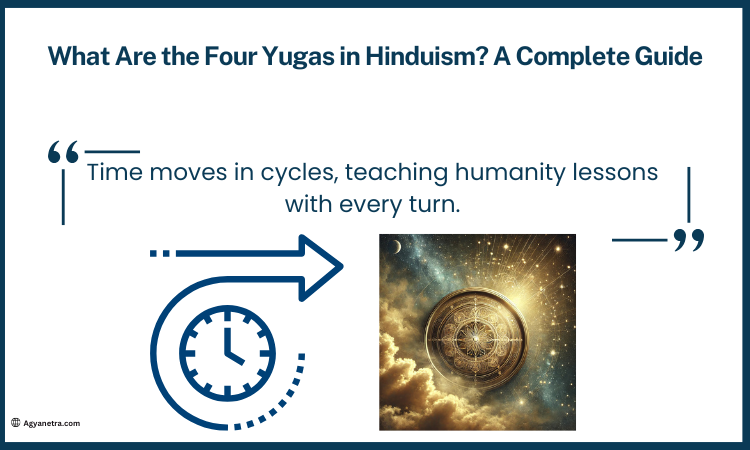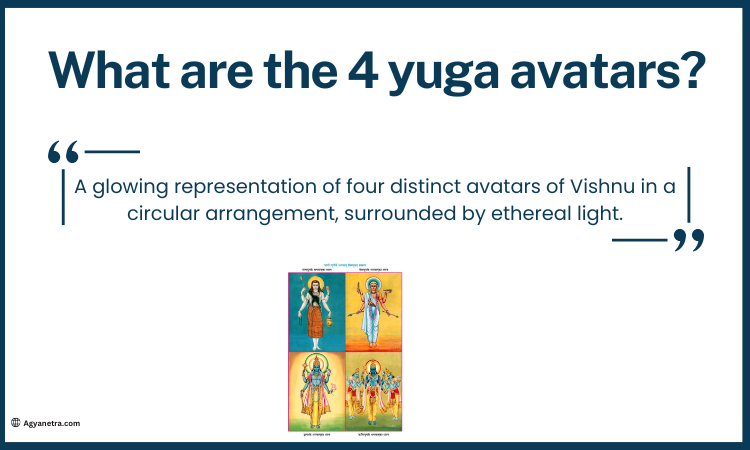What Are the Four Yugas in Hinduism? Have you ever wondered how time is perceived in Hinduism? In this fascinating journey through the Four Yugas, you’ll discover how Hindu scriptures divide human history into distinct ages, each with unique qualities, challenges, and lessons.
These Yugas—Satya, Treta, Dwapara, and Kalyug—not only tell the story of humanity’s spiritual evolution but also hold timeless wisdom for our modern lives.
Are you curious about what makes each Yuga special or why Kalyug is called the “Age of Darkness”?
Keep reading to uncover the deeper meaning behind these eras, their influence on human life, and practical tips for navigating the challenges of our current age.
This guide is your gateway to understanding the cyclical nature of time in Hindu philosophy and how it shapes our world.
What Are the Four Yugas in Hinduism? A Complete Guide
What if time itself could reveal the moral and spiritual evolution of humanity? Hinduism introduces us to the concept of Yugas, recurring cycles that divide human civilization into distinct phases.

Each Yug, or age, has its unique characteristics, challenges, and spiritual significance, representing the highs and lows of human life.
These Yugas form a fascinating framework that connects the past, present, and future of mankind.
Let’s see the Four Yugas in Hinduism and understand the current era, Kalyug, we are living in today.
What Are the Four Yugas in Hinduism?
Hindu scriptures describe four Yugas that follow a descending cycle of morality, spirituality, and life expectancy.

Each Yug plays a vital role in shaping human civilization. The four Yugas are:
- Satya Yug (Golden Age)
- Treta Yug (Silver Age)
- Dwapara Yug (Bronze Age)
- Kalyug (Iron Age)
Let’s explore each Yug to understand its significance and how it contributes to the journey of mankind.
You May Love: Who Are the Dus Mahavidyas? Stories, Mantras, and Significanc
The Satya Yug: The Age of Truth
Known as the Golden Age, Satya Yug represents the pinnacle of morality and spiritual purity.
This phase lasted for an astounding 1,728,000 years, with humans enjoying a life expectancy of 100,000 years. The hallmark of Satya Yug was a deep commitment to Dharma (righteousness).
People lived in perfect harmony, practicing meditation and yoga, with no conflicts or disparities.
Unlike today, communication was direct and did not rely on writing or art forms. For instance, temples were unnecessary as individuals could feel the divine presence everywhere.
According to mythology, this age witnessed Lord Shiva’s marriage to Goddess Sati, symbolizing the union of purity and divinity. Respect for nature and its resources was at its peak, and humans treated the Earth as a sacred entity.
Treta Yug: The Dawn of Materialism
Treta Yug lasted for 1,296,000 years and marked a gradual decline in spiritual practices. Life expectancy reduced to 10,000 years, and humans began exploring material comforts.
Agriculture and mining emerged as key occupations, symbolizing the growing complexity of human life.
The caste system was introduced during this era, dividing society into four classes: Brahmanas, Kshatriyas, Vaishyas, and Sudras.
Unlike the rigid systems seen later, these divisions were harmonious, with individuals contributing to society based on their roles.
This age is significant for the emergence of the Ramayana, which imparted timeless lessons on morality and duty. Treta Yug also witnessed three avatars of Lord Vishnu, including Lord Rama, who exemplified the ideals of truth, sacrifice, and justice. However, conflicts and feelings like jealousy and anger began to surface, indicating the onset of human flaws.
Dwapara Yug: The Age of Duality
The Bronze Age, or Dwapara Yug, lasted 864,000 years and saw a further decline in spirituality.
Life expectancy dropped to 1,000 years, and human behavior became more self-centered and competitive. People drifted away from their godly nature, seeking power and wealth at the cost of others.
The epic Mahabharata, which captures the struggles of righteousness and morality, belongs to this age. It was also during this time that Lord Krishna descended to restore balance and guide humanity toward peace.
Temples became a common place for worship, reflecting humanity’s need to reconnect with the divine amid rising chaos.
While immorality increased, some kind-hearted rulers worked tirelessly for the welfare of their people, symbolizing the dual nature of this Yug—where good and evil coexisted.
Kalyug: The Age of Darkness
The Kalyug, or Iron Age, is the shortest of all Yugas, lasting 432,000 years. We are currently living in this phase, characterized by materialism, greed, and spiritual decline.
Life expectancy has plummeted to around 100 years, and values like respect, humility, and selflessness have diminished.
This age is the exact opposite of Satya Yug. People are consumed by material desires, losing touch with their spiritual selves.
For example, political corruption, environmental exploitation, and widespread social discord are rampant in Kalyug.
According to Hindu mythology, Kalyug began after Lord Krishna departed from Earth, leaving humanity to navigate an era of darkness and challenges.
The Challenges of Kalyug
Living in Kalyug comes with its unique set of hardships. Climate crises like floods and droughts, pandemics, wars, and corruption dominate this age. Family bonds and values have weakened, and behavioral issues like ego and selfishness prevail.
For instance, modern society’s obsession with material wealth often leads to the exploitation of natural resources and a disconnect from spirituality.
These challenges make it imperative for individuals to adopt practices that can bring peace and balance to their lives.
How to Navigate Life in Kalyug
While we cannot change the nature of Kalyug, there are ways to lead a fulfilling and peaceful life:
- Embrace spirituality: Practice meditation, prayer, or yoga to achieve mental clarity and peace.
- Cultivate humility: Treat others with respect and kindness, regardless of their background.
- Care for the environment: Reduce waste, conserve resources, and respect nature.
- Value ethics over materialism: Lead a simple life focused on moral values rather than chasing material comforts.
For example, small acts like planting trees, helping those in need, or spending time in self-reflection can create a ripple effect of positivity in the world.
What Lies Ahead After Kalyug?
Hindu mythology predicts that Kalyug will end with a phase of destruction, paving the way for the return of Satya Yug, the Golden Age.

The cycle of Yugas symbolizes renewal and evolution, teaching us that no phase lasts forever.
This eternal cycle inspires hope that humanity can rise to its moral and spiritual peak again.
Conclusion
Understanding the Four Yugas in Hinduism gives us a deeper insight into the spiritual and moral evolution of mankind.
From the harmony of Satya Yug to the challenges of Kalyug, each age offers lessons that are still relevant today.
While Kalyug may seem overwhelming, adopting values like compassion, humility, and respect can help us navigate its challenges and contribute positively to the world.
In this age of darkness, the choice to bring light lies within us. Let’s strive to live meaningful lives that reflect the wisdom of these timeless Yugas.

Vidushi Gupta is an accomplished writer and digital marketing expert with contributions to organizations like Miles Educomp and ICAI. She has authored nearly ten novels and worked as a Senior Content Writer and Digital Marketing Specialist at ESS Global and Shabd. Her Quora posts have amassed almost 20 million views, reflecting her belief in the transformative power of the written word.

